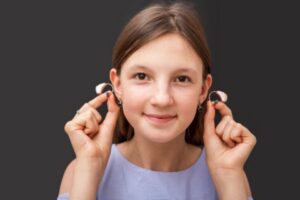Hearing Loss in Infants and Children

One of the biggest myths about hearing loss is that it affects only older adults. The truth is that not only does hearing loss affect middle-aged and young adults, it also affects infants and children. In fact, about 2 to 3 out of every 1,000 children in the United States are born with a detectable level of hearing loss in one or both ears, and this statistic increases with age: 5 per 1,000 children aged 3-16 have detectable hearing loss in one or both ears.
The auditory part of the brain — critical for learning language, speech perception, speech production, and literacy — develops through exposure to sound. Even minor hearing loss can significantly affect a child’s ability to develop communication, language, and social skills.
Signs of Hearing Loss in Infants and Children
Signs that a baby may be experiencing hearing loss include:
- Birth to 4 months
- Doesn’t react to loud sounds
- Doesn’t respond to voices
- 4-12 months
- Doesn’t respond to toys that make noise
- Doesn’t make babbling noises
- 12-24 months
- Can’t follow basic commands
- Can’t say simple words
Toddlers and older children may exhibit hearing loss through the following behaviors:
- Can’t understand what people are saying
- Doesn’t respond or responds with incorrect information
- Speaks differently than other children of the same age
- Turns up the volume on electronic devices
- Has speech or language delays
- Watches others to imitate their responses and reactions
- Says “what?” or “huh?” often
- Watches a speaker’s face very intently (lip reading)
Treating Hearing Loss in Infants and Children
Depending on the cause and severity of hearing loss, treatments can include removal of ear wax or foreign objects, treating an infection with antibiotics, surgery, speech therapy, hearing aids, cochlear implants, assistive listening devices, or a combination of these treatments.
Speech Therapy
For children who have an auditory processing disorder, speech therapy alone may be enough to help them strengthen the way they understand and use language. For most other children with hearing loss, speech therapy is a complementary treatment in addition to a hearing aid or cochlear implant. Speech therapy may include sign language or lip reading to enhance the ability to understand and communicate with others. Speech therapy encourages the development of develop oral skills and can help a child feel more comfortable and confident.
Hearing Aids
Hearing aids work by amplifying sound. Children as young as a few months old can wear hearings aids. Pediatric hearing aids are like adult hearing aids, but tend to be more durable, have tamper-resistant battery cases, and are compatible with assistive listening devices that filter out unwanted noise, which can be particularly beneficial in a school setting. There are several models to choose from; behind-the-ear style hearing aids are ideal for children as they are best suited for their growing ears.
Cochlear Implants
When an infant or child’s hearing loss is severe, hearing aids may not be enough, and a cochlear implant may be a better solution. Unlike hearing aids that amplify sound, a cochlear implant is a surgically implanted device that redirects sound signals to the auditory nerve, bypassing damaged portions of the ear. Cochlear implants consist of multiple parts: one that hooks over the ear or is worn on the head, and another that is surgically placed under the skin on the temporal born, as well as electrodes placed in the inner ear. Pediatric cochlear implants often feature a soft headband to keep the device in place.
Assistive Listening Devices
Assistive listening devices are accessories that can help a child hear better in addition to a hearing aid or cochlear implant. In a setting such as a classroom, playground, or sporting event, children may struggle to hear even with a hearing aid or cochlear implant because of excessive background noise. An assistive listening device creates a direct connection between the child and another person, such as a teacher, coach, or parent. The other person wears a microphone that transmits sound directly to a receiver on the child’s device, minimizing any interfering sound.
A Child’s Hearing Care Team
A child’s hearing care begins at birth with a newborn hearing exam to immediately detect any hearing impairment that could delay language development. Hearing screenings typically continue through childhood and if an impairment is detected, a pediatrician can conduct a preliminary exam and will likely refer the child to an audiologist or an ear, nose, and throat (ENT) doctor (otolaryngologist). The ENTs at Florida Gulf Coast ENT and the audiologists at Florida Gulf Coast Hearing Center will work together to determine the cause of hearing loss and develop an appropriate treatment plan.
